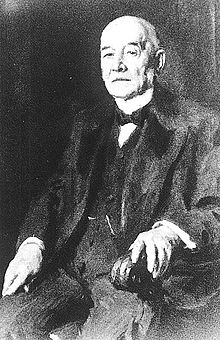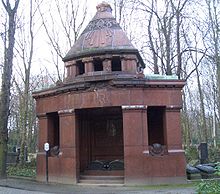Sigmund Aschrott
Sigmund Aschrott (born June 14, 1826 in Hochheim am Main , † May 5, 1915 in Berlin ) was a German-Jewish businessman , industrialist , banker and real estate entrepreneur. He opened up the so-called Front West , a district of Kassel .
Life
family
Sigmund Aschrott married Anna Hertz (1833–1890) in 1855, she is the namesake for Annastr. to be seen in Kassel. The five children, son Paul Felix and four daughters Julie (husband Victor v. Boschan, Vienna), Hedwig (Alphonse Strauss, London), Olga (Dr. Alfred Mengers, Berlin) and Marie (Artur v. Boschan, Vienna), had the couple baptized.
publisher
After a commercial apprenticeship in Frankfurt am Main , the parents returned from Hochheim to Kassel in 1836, S. Aschrott switched to his father's linen trade in 1844 and converted it into a publishing house . While the weavers previously sold their weekly production to the dealer and got money and yarn for it, S. Aschrott had the home weavers in structurally weak areas in North Hesse such as Melsungen , Spangenberg , Eschenstruth and the Meißner make orders. He obtained major orders from railway companies and companies in a rapidly growing industry. The publisher invested part of the added value in changing and renewing the looms . With most of the profit he bought up large areas of land or invested his money in the capital market. In the end, many of Aschrott's former employees in Kassel and the surrounding area made the switch to industrial linen production.
Large landowners
From the mid-1860s, Aschrott bought large areas of land in the districts of Kassel, Wehlheiden , Kirchditmold and Wahlershausen to the west of the last urban expansion developed during the electoral era, the so-called Friedrich-Wilhelm-Stadt . The streets and squares, sewer systems and tree planting he had promoted were initially operated and financed by his “building consortium” and then by himself. In the first construction phase from Ständeplatz to Querallee, the entrepreneur did not have the total area and the implementation repeatedly stalled because small investors blocked in order to generate maximum profit with their space.
District planner
During the implementation in the section from Querallee to the west towards Habichtswald with a view of the Hercules , the planners had to struggle with considerable differences in height. In this part, diagonal connections in the street grid were used in addition to the development, which corresponded to the current trend in urban development. A perimeter block development with four or five-storey building blocks represented the optimal form for the quarter design in order to generate a sustainable profit. The entrepreneur Aschrott and his private master builder Wilhelm Neumann were responsible for the planning itself. The cooperation with the city, represented by Mayor Emil Weise , was regulated by urban development contracts and a statute published in 1884 . The planners placed particular emphasis on planning the longitudinal streets like Wilhelmshöher Allee so that a view of the Hercules was possible. These routes were related to each other with cross connections. The widest of these connecting streets was called "Aschrottstraße". Looking at Hercules, the planners made an absolutist assumption about the dependence of the subordinate on the regent.
At the end of the 1860s, the entrepreneur tried to set up a horse-drawn railway in the emerging district , but failed due to resistance from the administration. In the mid-1970s, Aschrott proposed a through station not far from today's Kassel-Wilhelmshöhe station . Here Kassel merchants were massively opposed to further planning, because with the emphasis on the relocation of rail traffic, the main station would have lost its attractiveness and consequently the shops would have lost sales. In addition to his special project for “upscale living” in Kassel, the large landowner, as previously determined, carried out other residential quarters in Berlin-Pankow , Frankfurt and Chemnitz .
Army supplier
In the war against France in 1870/71, Aschrott was in charge of supplying a large part of the Prussian army (over 100,000 men and horses) with food and feed, until he was relieved of all duties at the end of 1870 because of an alleged bribery of an official. The District Court of Kassel rejected the allegation of bribery, "because the facts were not recognizable".
Hostility
Anti-Semitic attacks were not restricted to the military headquarters. Aschrott also met with rejection from Jewish fellow believers, as well as from Kassel business people, who saw a relocation of trade coming with the expansion of the new Hohenzollernviertel. Likewise, hostilities can be demonstrated at all levels of administration. The anti-Semitic Berlin press became aware of the entrepreneur late in order to denounce him with common defamations such as usury, emergency trade, goods battles or an application for ennoblement. During the Nazi era, citizens of Kassel destroyed the " Aschrottbrunnen " that he had donated for the construction of the town hall . They tore down the obelisk and planted flowers in the pool of water. The vernacular referred to the site as "Ashrotts grave".
After 24 years of efforts, Aschrott succeeded in being appointed to the Kommerzienrat , until then the appointment always failed due to the veto of the War Ministry, until in 1900 the leadership of the 11th Army Corps in Kassel supported the application. After the banker supported the special concern of Wilhelm II , the expansion of the Saalburg as well as his "private box", with generous donations, further awards followed such as the award of the Prussian Order of the Crown, 2nd class and the Red Eagle Order, 3rd class, as well as the appointment to the secret Commerce Council .
Ash mausoleum
The Aschrotts found their final resting place in the Jewish cemetery in Berlin-Weißensee in the mausoleum designed by the architect Bruno Schmitz , which is said to be the largest and most elaborate in Berlin today. The mausoleum is located in field C.
In 1904 Aschrott had his wife Anna, who died in Vienna in 1890, reburied in the mausoleum built in 1903–1904, as can be seen from the files in the death register in the cemetery administration.
Bruno Schmitz incorporated guidelines and ideas for large monuments from the Wilhelmine era for the construction of the burial house. The Kaiser Wilhelm National Monument at Kyffhäuser and the Völkerschlachtdenkmal in Leipzig come from his pen .
District today
After the old town was almost completely destroyed in the Second World War, Aschrott's urban planning work, today's Vordere West , with its cultural monuments and green streets and squares, became one of the most popular residential areas in Kassel.
Aschrott's donations and foundations
With extensive donations, Aschrott supported public and private institutions and projects such as the warrior memorial, the construction of the Kassel Tivoli, the naturalists' meeting, tourism, the patriotic women's association, the women's association for nursing, equipping the Jewish orphanage, and his dowry foundation Parents and the Aschrottbrunnen in front of the town hall. He also transferred land for the construction of various churches as well as funds for the construction of the town hall and founded a fund for needy family members. With foundations like the “Dr. Aschrott Wohlfahrtshaus ”and the facility“ Marie v. Boschan-Aschrott Altersheim ”as well as the donation of extensive land to the city of Kassel, his son Felix Aschrott (district court director) and his youngest daughter Marie v. Boschan continued his father's charitable efforts.
Aschrott foundations
His son, Regional Court Director Felix Aschrott (1858–1927), who first lived in Elberfeld and then in Berlin, bequeathed two thirds of his assets worth almost three million Reichsmarks to two foundations that were to benefit the city of Kassel and its citizens: the Foundation “Dr. Aschrott Wohlfahrtshaus ”and the“ Marie von Boschan-Aschrott Retirement Home ”foundation. Architectural competitions were initially held for the construction of both facilities; The jury also included Karl Roth , the architect of the Kassel town hall and the Ashrott fountain. The “Marie von Boschan-Aschrott old people's home” was then built from mid-1930 to early 1932 according to the winning competition design by the architect Otto Haesler from Celle; the construction management was done by the municipal building department. The building - also popularly mocked as the “Aunties Aquarium” because of the large windows in the living quarters - attracted a great deal of attention in specialist circles at the time and is now one of the most important architectural monuments from the New Building era in Germany.
literature
- Baetz, Karl: Notes on the secret councilor Sigmund Aschrott and its importance for the economic and urban development of Kassel. (Records - typescript), Kassel 1951
- Demme, Roland: The Jewish merchant, publisher and town planner Sigmund Aschrott - a personality of the 19th century. (Dissertation - KOBRA-DSpace of the University of Kassel), Kassel 2006
- Knobling, Annette, Schrader Wolfgang: Sigmund Aschrott - A far-reaching city designer or an ordinary property speculator? (Scientific term paper for the first state examination), Kassel 1986
- Wiegand, Thomas: Monument Topography Federal Republic - Art Monuments Hesse - City of Kassel II - Vorderer West Südstadt Auefeld Wehlheiden, Wiesbaden 2005
Web links
Individual evidence
- ↑ Demme 2006, p. 200
| personal data | |
|---|---|
| SURNAME | Aschrott, Sigmund |
| BRIEF DESCRIPTION | Industrial and real estate investor |
| DATE OF BIRTH | June 14, 1826 |
| PLACE OF BIRTH | Hochheim am Main |
| DATE OF DEATH | May 5, 1915 |
| Place of death | Berlin |

